AUDI TT ROADSTER 2014 Owners Manual
Manufacturer: AUDI, Model Year: 2014, Model line: TT ROADSTER, Model: AUDI TT ROADSTER 2014Pages: 244, PDF Size: 60.87 MB
Page 111 of 244
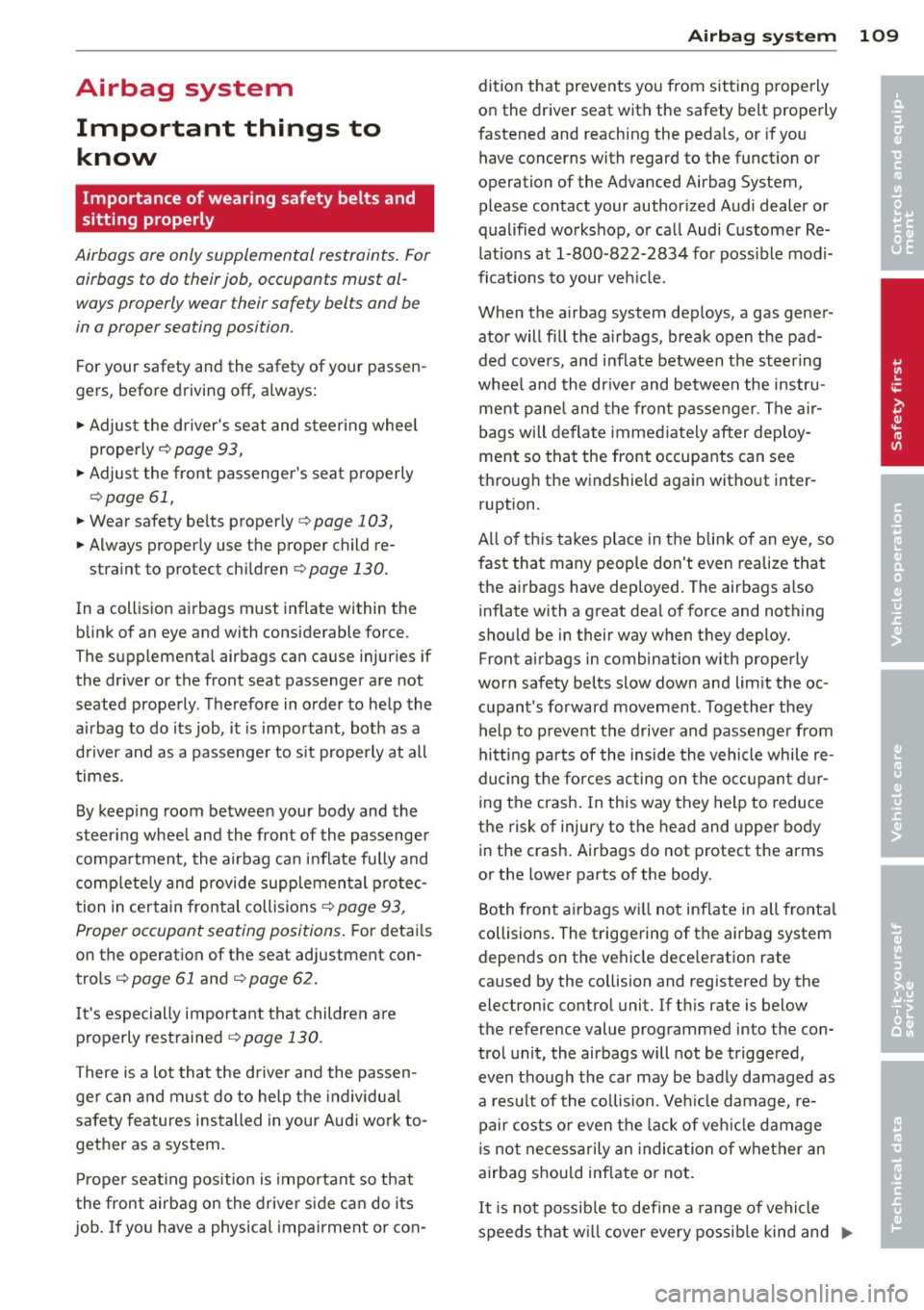
Airbag system Important things to know
Importance of wearing safety belts and
sitting properly
Airbags are only supplemental restraints. For
airbags to do their job, occupants must al
ways properly wear their safety belts and be
in a proper seating position.
For your safety and the safety of your passen
gers, before driving off, always:
"" Adjust the driver's seat and steering wheel
properly¢
page 93,
"" Adjust the front passenger's seat properly
¢page 61,
""Wear safety be lts properly ¢ page 103,
""Always properly use the proper child re-
straint to protect children
r::::> page 130.
In a collision airbags must inflate within the
blink of an eye and with considerable force.
The supplemental airbags can cause injuries if
the driver or the front seat passenger are not
seated properly . Therefore in order to help the
airbag to do its job, it is impo rtant, both as a
d river and as a passenger to s it properly at all
times.
By keeping room between your body and the
steer ing whee l and the front of the passenger
compartment, the airbag can inflate fully and
comp lete ly and provide supplemental protec
tion in certain frontal collisions
r::::> page 93,
Proper occupant seating positions.
F or details
on the operation of the seat adjustment con
trols ¢
page 61 and ¢ page 62.
It's especially important that children a re
properly restrained
r::::> page 130.
There is a lot that the driver and the passen
ger can and must do to help the individua l
safety features installed in your Aud i work to
gether as a system.
Proper seating pos ition is important so that
the front airbag on the driver side can do its
job. If you have a physical impairment or con-
Airbag system 109
dition that prevents you from sitting properly
on the driver seat with the safety belt properly
fastened and reach ing the pedals, or if you
have concerns with regard to the function or
operation of the Advanced Airbag System,
please contact your authorized Audi dealer or
qualified workshop, or call Audi Customer Re
lations at 1-800-822-2834 for poss ible modi
fications to your vehicle.
When the airbag system dep loys, a gas gener
ator will fill the a irbags, break open the pad
ded covers, and inflate between the steer ing
whee l and the driver and between the instru
ment panel and the front passenger. The air
bags will deflate immediately after deploy
ment so that the front occupants can see
through the windshield again without inter
ruption.
A ll of th is takes place in the blink of an eye, so
fast that many people don't even realize that
the airbags have deployed. The airbags a lso
inflate with a great dea l of force and nothing
should be in their way when they deploy.
Front airbags in combination with properly
worn safety belts slow down and lim it the oc
cupant's forward movement. Together they
help to prevent the driver and passenger from
hitt ing parts of the inside the vehicle while re
ducing the forces acting on the occupant dur
ing the crash . In this way they help to reduce
the risk of injury to the head and upper body
in the crash. Airbags do not protect the arms
or the lower parts of the body.
Both front airbags will not inflate in all fronta l
collisions . The triggering of the airbag system
depends on the vehicle dece leration rate
caused by the co llision and registered by the
electronic control unit. If th is rate is below
the reference value programmed into the con
trol unit, the airbags will not be triggered,
even though the car may be badly damaged as
a result of the collision . Vehicle damage, re
pair costs or even the lack of veh icle damage
is not necessarily an indication of whether an
airbag shou ld inf late or not .
It is not possible to define a range of vehicle
speeds that will cover every possible kind and ..,. •
•
Page 112 of 244
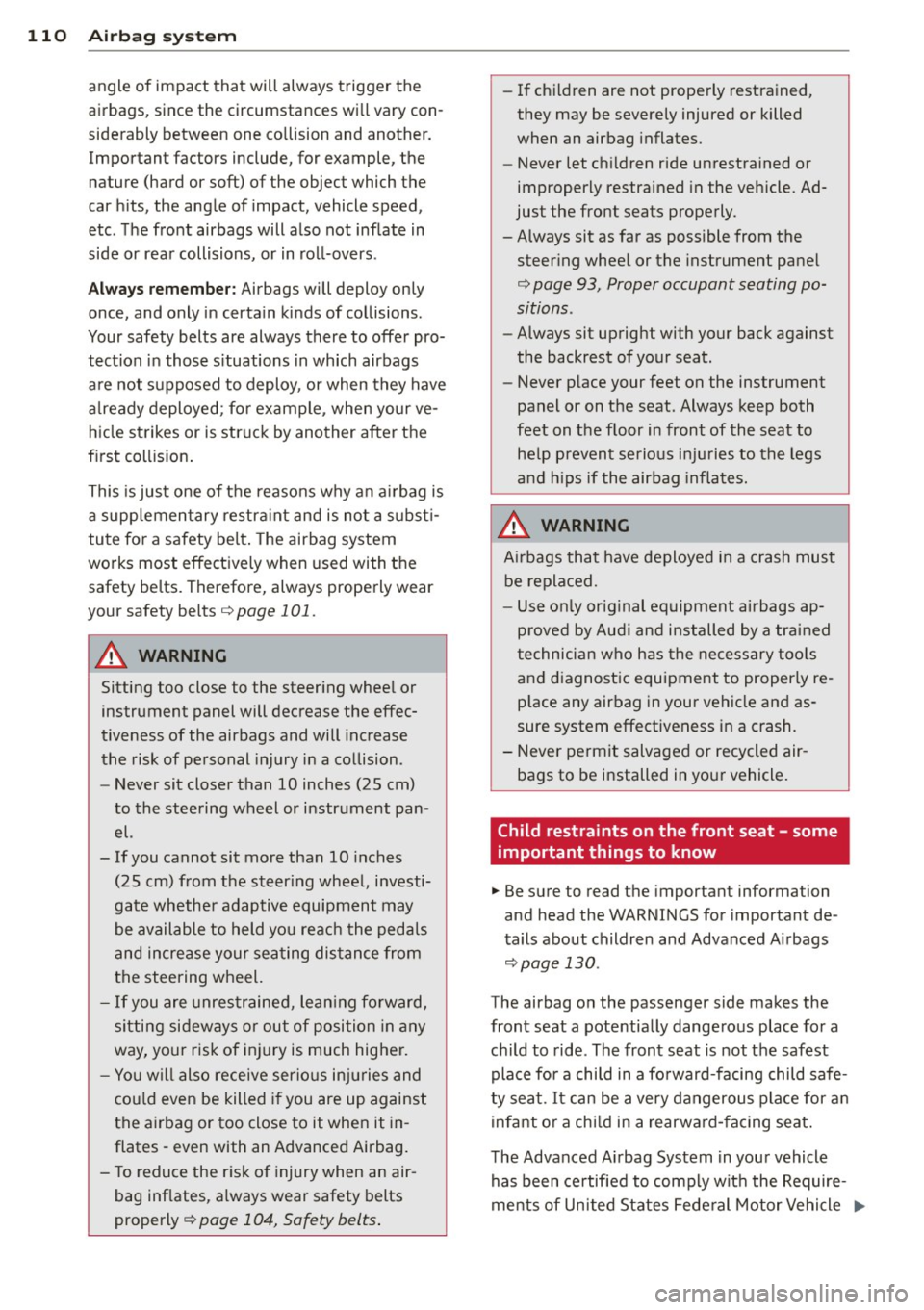
110 Airbag system
angle of impact that will always trigger the
airbags, since the circumstances will vary con
siderably between one collision and another.
Important factors include, for example, the
nature (hard or soft) of the object which the
car hits, the angle of impact, vehicle speed,
etc. The front airbags will also not inflate in
side or rear collisions, or in roll-overs.
Always remember: Airbags will deploy only
once, and only in certain kinds of collisions.
Your safety belts are always there to offer pro
tection in those situations in which airbags
are not supposed to deploy, or when they have
already deployed; for example, when your ve hicle strikes or is struck by another after the
first collision.
This is just one of the reasons why an airbag is
a supplementary restraint and is not a substi
tute for a safety belt. The airbag system
works most effectively when used with the
safety belts. Therefore, always properly wear
your safety belts¢
page 101.
A WARNING
Sitting too close to the steering wheel or
instrument panel will decrease the effec
tiveness of the airbags and will increase
the risk of personal injury in a collision .
- Never sit closer than 10 inches (25 cm)
to the steering wheel or instrument pan el.
- If you cannot sit more than 10 inches
(25 cm) from the steering wheel, investi
gate whether adaptive equipment may
be available to held you reach the pedals
and increase your seating distance from
the steering wheel.
- If you are unrestrained, leaning forward,
sitting sideways or out of position in any
way, your risk of injury is much higher.
- You will also receive serious injuries and
could even be killed if you are up against
the airbag or too close to it when it in
flates -even with an Advanced Airbag.
- To reduce the risk of injury when an air
bag inflates, always wear safety belts
properly
c::> page 104, Safety belts.
- If children are not properly restrained,
they may be severely injured or killed
when an airbag inflates.
- Never let children ride unrestrained or
improperly restrained in the vehicle. Ad
just the front seats properly.
- Always sit as far as possible from the steering wheel or the instrument panel
¢ page 93, Proper occupant seating po
sitions.
- Always sit upright with your back against
the backrest of your seat.
- Never place your feet on the instrument
panel or on the seat. Always keep both
feet on the floor in front of the seat to help prevent serious injuries to the legs
and hips if the airbag inflates.
A WARNING
Airbags that have deployed in a crash must
be replaced.
- Use only original equipment airbags ap
proved by Audi and installed by a trained
technician who has the necessary tools
and diagnostic equipment to properly re
place any airbag in your vehicle and as
sure system effectiveness in a crash.
- Never permit salvaged or recycled air bags to be installed in your vehicle.
Child restraints on the front seat - some
important things to know
.. Be sure to read the important information
and head the WARNINGS for important de
tails about children and Advanced Airbags
¢page 130.
The airbag on the passenger side makes the
front seat a potentially dangerous place for a
child to ride. The front seat is not the safest
place for a child in a forward-facing child safe
ty seat.
It can be a very dangerous place for an
infant or a child in a rearward-facing seat.
The Advanced Airbag System in your vehicle
has been certified to comply with the Require
ments of United States Federal Motor Vehicle .,.
Page 113 of 244
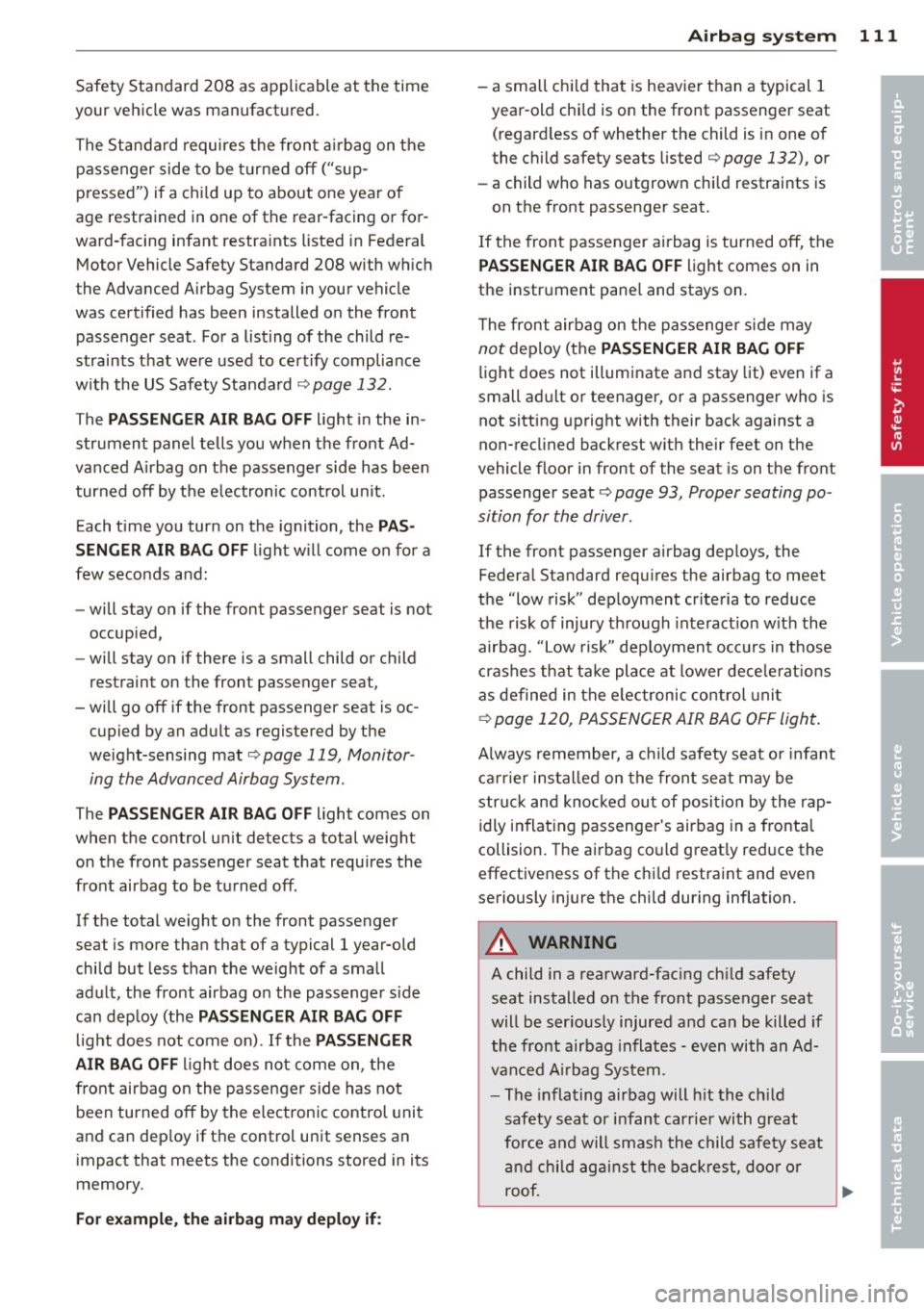
Safety Standard 208 as applicable at the time
your vehicle was manufactured.
The Standard requires the front a irbag on the
passenger side to be t urned off ("sup
pressed") if a child up to about one year of
age restrained in one of the rear -facing or for
ward -facing infant restra ints listed in Federal
Motor Vehicle Safety Standard 208 with wh ich
the Advanced Airbag System in your vehicle
was certified has been installed on the front passenger seat. Fo r a listing of the child re
straints that were used to certify compliance
with the US Safety Standard
¢ page 132.
The PAS SENG ER AIR BAG OFF light in the in
strument panel tells you when the front Ad
vanced A irbag on the passenger side has been
turned off by the e lectronic control u nit.
Each t ime you turn on the ignition, the
PAS
SENGER AIR BAG OFF
l ight w ill come on for a
few seconds and:
- will stay on if the front passenger seat is not
occupied,
- will stay on if there is a small child or child
restraint on the front passenger seat,
- wi ll go off if the front passenger seat is oc
cupied by an adult as registered by the
weight-sensing mat
¢ page 119, Monitor
ing the Advanced Airbag System.
The PASSENGER AIR BAG OFF light comes on
when the control un it detects a total weight
on the front passenger seat that requires the
front airbag to be turned off .
If the total weight on the front passenger
seat is more than that of a typical 1 year-old
chi ld but less than the weight of a small
ad ult, the front airbag on the passenge r side
can dep loy (the
PASSENGER AIR BAG OFF
light does not come o n). If the PASSENGER
AIR BAG OFF
l ight does not come on, the
front airbag on the passenger side has not
been turned off by the electronic control unit
and can dep loy if the control unit senses an
impact that meets the conditions stored in its
memory.
For e xample , the airbag may deploy if :
Airbag system 11 1
- a small child that is heav ie r th an a typical 1
year -old chi ld is o n the front passenger seat
(regard less o f whether the child is in one o f
the child safety seats listed ¢
page 132), or
- a child who has outgrown child restraints is
on the front passenger seat.
If the front passenger airbag is turned off, the
PASSENGER AIR BAG OFF light comes on in
the instr ument pane l and stays on.
T he front airbag on the passenge r side may
not deploy (t he PASSENGER AIR BAG OFF
light does not illuminate a nd stay lit) even if a
small ad ult or teenager, or a passenger who is
not sitting upright with their back against a
non-recl ined backrest w ith their feet on the
vehicle floor in front of the seat is on the front
passenger seat ¢
page 93, Proper seating po
sition for the driver.
If the front passenger airbag dep loys, the
Federa l Standard requ ires the airbag to meet
the "low risk" dep loyment criteria to reduce
the risk of injury th rough interact ion w ith the
airbag. "Low risk" deployment occurs in those
crashes that ta ke place at lower dece le rat io ns
as de fined in the e lectronic co ntrol unit
¢ page 1 20, PASSENG ER AIR BAG O FF light.
Always remember, a c hild safety seat or infant
ca rr ier installed on the front seat may be
stru ck and kno cked out of po sit io n by the rap
idly in flat ing passenger 's airbag in a fronta l
collision. The ai rbag co uld great ly red uce the
effectiveness of the chi ld restraint and even
seriously in jure the child during inflation.
A WARNING
A child in a rearward-fac ing ch ild safety
seat installed on the front passenger seat
will be ser ious ly injured and can be killed if
the front airbag inflates - even with an Ad
van ced A irbag System.
- The inflating airbag will h it the ch ild
safety seat or infant carrie r with great
for ce and will smas h the child safety seat
a nd child ag ain st the ba ckrest, door o r
roof.
•
•
Page 114 of 244
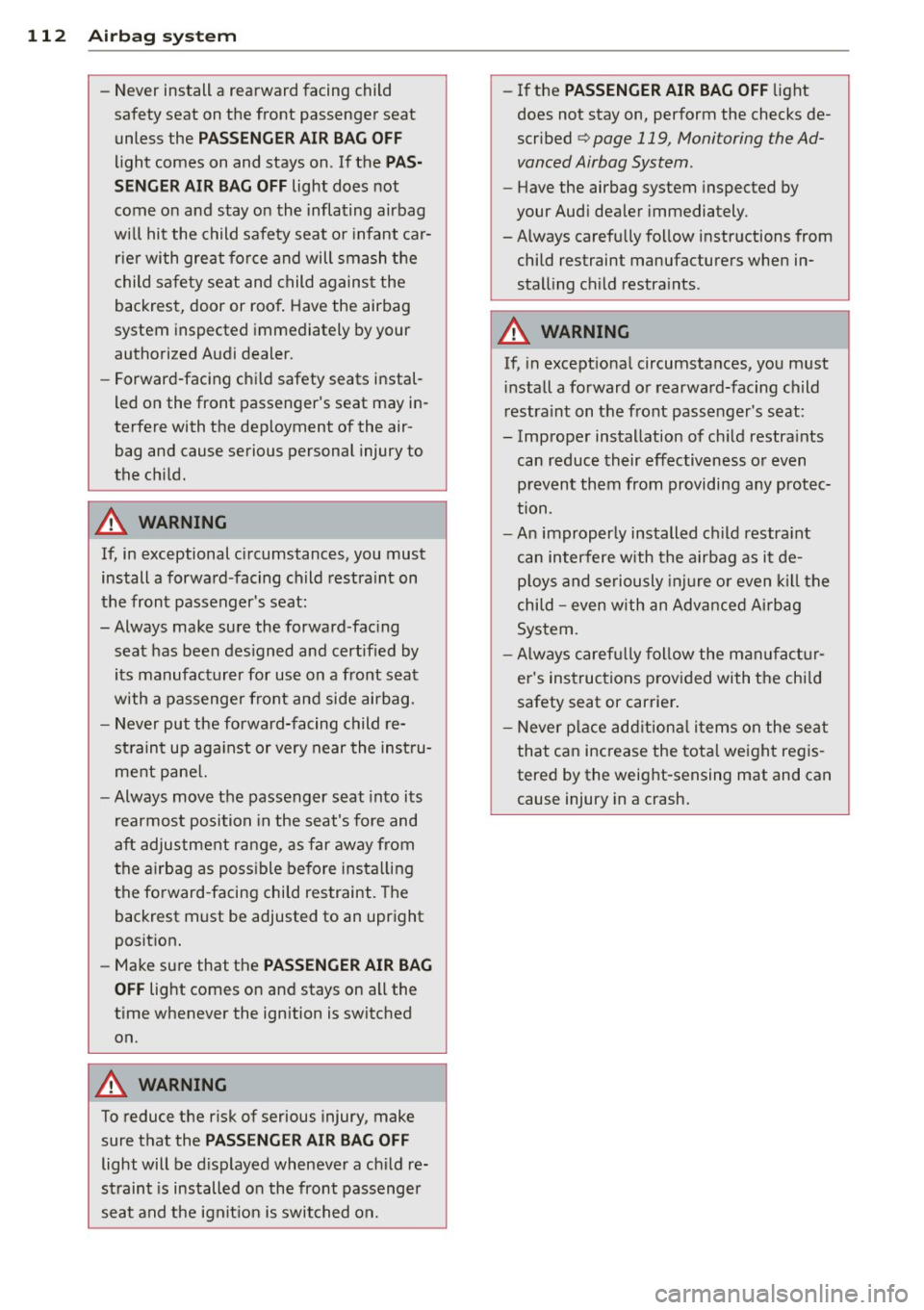
112 Airbag sys te m
- Never install a rearward facing child
safety seat on the front passenger seat
unless the
PA SS EN GER AIR B AG OFF
light comes on and stays on . If the P A S
SE NGER AI R BA G OFF
light does not
come on and stay on the inflating airbag
wi ll hit the child safety seat or infant car
rier with great force and will smash the
child safety seat and child agains t the
backrest, door or roo f. Have the airbag
system inspected immediately by your
authorized Audi dealer .
- Forward-facing chi ld safety seats instal
led on the front passenger's seat may in
terfere with the deployment of the air bag and cause serious personal injury to
the ch ild.
A WARNING
If, in exceptional c ircumstances, you must
install a forward -facing child restra int on
the front passenger's seat:
- Always make sure the forward -fac ing
seat has been des igned and certified by
its manufacturer for use on a front seat
with a passenger front and side airbag.
- Never put the forward-facing child re
straint up aga inst or very near the inst ru
ment pane l.
- Always move the passenger seat into its
rearmost position in the seat's fore and
aft adjustment range , as far away from
the a irbag as poss ible before installing
the fo rward-facing child restraint. The
backrest must be adjusted to an upright
position.
- Make sure that the
PASSENGER AIR BAG
OFF
light comes on and stays on all the
t ime whenever the ignition is switched
on.
A WARNING
To reduce the risk of serious injury, make sure that the
PASSENGER AI R BAG OFF
light will be d isplayed whenever a ch ild re
straint is installed on the front passenger
seat and the ignit ion is switched on. -
If the
PASSENGER AIR BAG OFF light
does not stay on, perform the checks de
scribed
<=> page 119, Monitoring the Ad
vanced Airbag System .
-Have the airbag system inspected by
your Aud i dea ler immediately.
- Always carefully follow instructions from
child restraint manufacturers when in
stall ing ch ild restra ints .
A WARNING
=
If, in except iona l circumstances, you must
i nstall a forward or rearwa rd-facing child
restra int on the front passenger's seat :
- Improper installation of ch ild restra ints
can reduce their effectiveness o r even
p revent them from providing any protec
tion .
- An improp erly installed ch ild restra int
can interfere with the airbag as it de
p loys and seriously inj ure o r even k ill the
child -even with an Advance d Airbag
System.
- Always carefu lly follow the m anu fact ur
er 's ins truc tions p rov ided with the chi ld
safety seat or carrier .
- Never p lace add itiona l it ems on the seat
that can increase the total weight regis
tered by the weight-sensing mat and can
cause injury in a crash.
Page 115 of 244
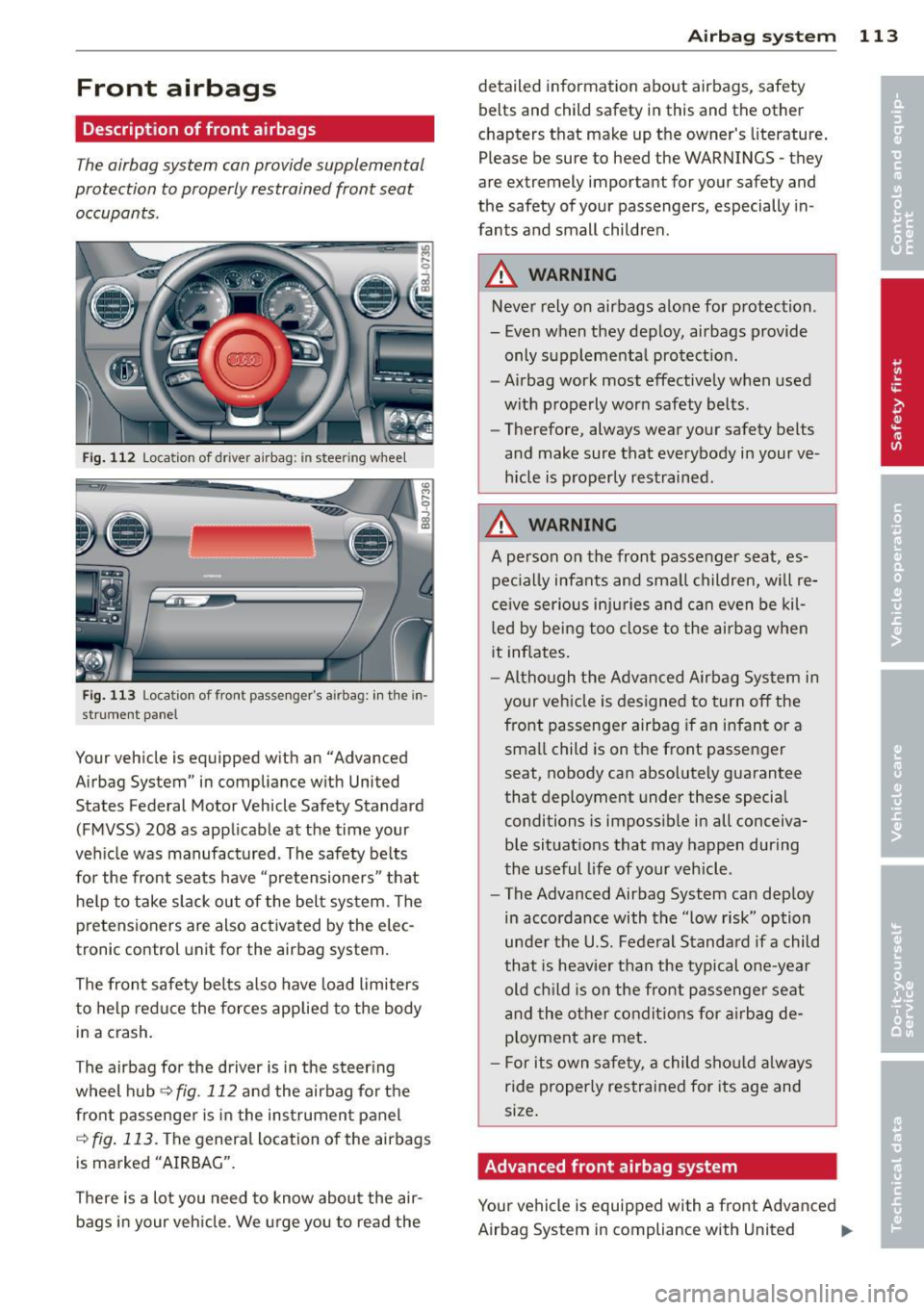
Front airbags
Description of front airbags
The airbag system can provide supplemental
protection to properly restrained front seat
occupants .
Fig. 112 Location of dri ver airbag: in steering whee l
Fig. 113 Location of front passe nger's ai rb ag : in the in
strument panel
Your vehicle is equipped with an "Advanced
Airbag System" in compliance with United
States Federal Motor Vehicle Safety Standard
(FMVSS) 208 as applicable at the time your
vehicle was manufactured . The safety belts
for the front seats have "pretensioners" that
help to take slack out of the belt system. The
pretensioners are also activated by the elec
tronic control unit for the airbag system.
The front safety belts also have load limiters
to help reduce the forces applied to the body
in a crash .
The airbag for the driver is in the steering
wheel hub¢
fig. 112 and the airbag for the
front passenger is in the instrument panel
¢fig. 113. The general location of the airbags
is marked "AIRBAG".
There is a lot you need to know about the air
bags in your vehicle. We urge you to read the
Airbag system 113
detailed information about airbags, safety
belts and child safety in this and the other
chapters that make up the owner's literature .
Please be sure to heed the WARNINGS - they
are extremely important for your safety and
the safety of your passengers, especially in
fants and small children.
A WARNING ,.;;
Never rely on airbags alone for protection .
- Even when they deploy, airbags provide
only supplementa l protection.
- Airbag work most effectively when used
with properly worn safety belts.
- Therefore, always wear your safety belts
and make sure that everybody in your ve
hicle is properly restrained.
A WARNING
A person on the front passenger seat, es
pecially infants and small children, will re
ceive serious injuries and can even be kil
led by being too close to the airbag when
it inflates .
- Although the Advanced Airbag System in
your vehicle is designed to turn off the
front passenger airbag if an infant or a
small child is on the front passenger
seat, nobody can absolutely guarantee
that deployment under these special
conditions is impossible in all conceiva
ble situations that may happen during
the useful life of your vehicle .
- The Advanced Airbag System can deploy
in accordance with the "low risk" option
under the U.S. Federal Standard if a child
that is heavier than the typical one-year
old child is on the front passenger seat
and the other condit ions for airbag de
ployment are met.
- For its own safety, a child should always
ride properly restrained for its age and
size.
Advanced front airbag system
-
Your vehicle is equipped with a front Advanced
Airbag System in compliance with United
Ill>
Page 116 of 244
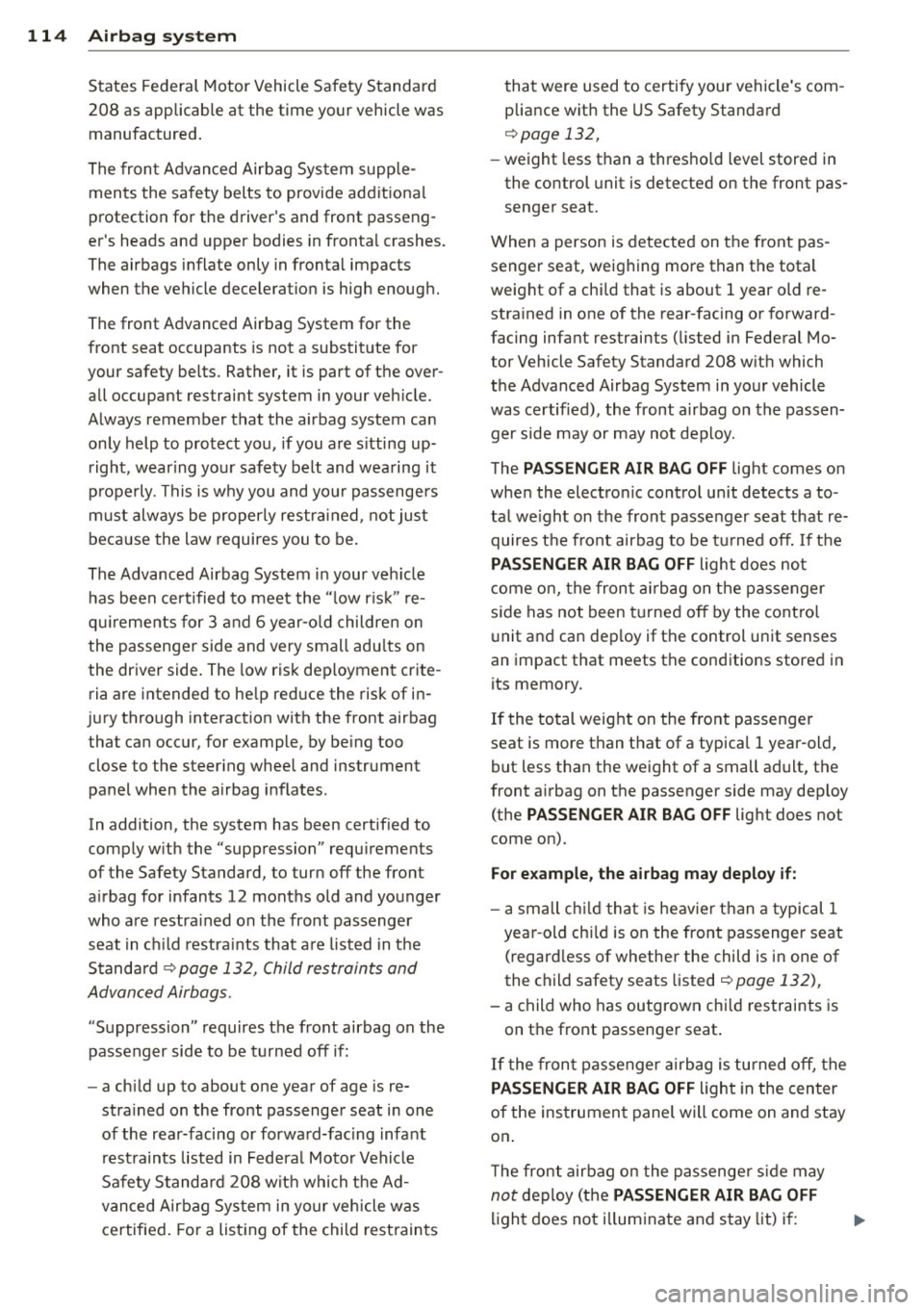
114 Airbag sys te m
States Federal Motor Vehicle Safety Standard
208 as applicable at the time your vehicle was manufactured .
The front Advanced Airbag Sys tem supp le
ments the safety belts to provide additional
protection for the driver's and front passeng
er 's heads and upper bodies in fronta l crashes.
The airbags inflate only in fronta l impacts
when the vehicle dece lerat ion is high enough.
The front Advanced Airbag System for the
front seat occupants is not a substitute for
your safety belts. Rather, it is part of the over all occupant restraint system in your veh icle.
A lways remember that the airbag system ca n
only help to protect you, if you are s itting up
right, wearing yo ur safety belt and wea ring it
p roperly. This is why you and you r passenge rs
must always be properly restr ained , not just
beca use the law requires you to be.
The Advanced Airbag System i n your veh icle
has been cer tified to meet the " low r is k " re
qu iremen ts for
3 an d 6 year-o ld childre n on
the passenger side and very small adu lts on
the driver side. The low risk deploymen t crite
ria are intended to he lp red uce the risk of in
jury through interaction with the front airbag that can occur, for example, by be ing too
close to the steer ing whee l and instrument
panel when the airbag i nflates .
In addition, the system has been certif ied to
comp ly w ith the "suppression" requ irements
of the Safety Standard, to tur n off the front
a irbag for infants
12 months old and younger
who a re restra ined on the front passenger
seat in c hild restra ints that a re listed in the
St anda rd ¢
page 132, Child restraints and
Advanced Airbags.
"Suppression" requires the front airbag on the passenger side to be turned off if :
- a ch ild up to about one year of age is re
stra ined on the front passenger seat in one
of the rear-facing or forwa rd-fac ing infa nt
rest raints listed in Federa l Motor Veh icle
Safety Standard 208 wit h whi ch the Ad
vanced Airbag System in your vehicle w as
certified . For a list ing of the child rest rain ts t
ha t were used to certify your vehicle 's com
pliance with the US Safety Standa rd
¢ page 132,
-weight less than a thres ho ld level stored in
the control unit is detected on the front pas
senger seat.
When a person is dete cted on the front pas
senger seat, weighing more than the tota l
weight of a chi ld that is about
1 year old re
stra ined in one of the rear-facing or forward
facing infant restraints ( listed in Federal Mo
tor Vehicle Safety Standard 208 w it h which
the Advanced Airbag System in your vehicle
was ce rtified), the front airbag on the passen
ger side may or may not deploy.
The
PASSENGER AIR BAG OFF light comes on
whe n the electro nic con trol unit detects a to
ta l we ight on the front passenger seat that re
quires t he front airbag to be tu rned off. If t he
PASSENGER AIR BAG OFF ligh t does no t
come o n, the fron t airbag on the passenger
s ide has not been turne d off by the cont ro l
u nit and can dep loy if the control unit senses
an impact that meets the conditions stored in
its memory.
If the total weight on the front passenge r
seat is more than that of a typica l
1 year-old,
but less than the we ight of a small ad ult, the
front a irbag on the passenger side may dep loy
(the
PASSENGER AIR BAG OFF light does not
come on).
For example , the airbag may deploy if:
- a small ch ild that is heav ier t han a typic al 1
yea r-old ch ild is on the front passenger seat
(regard less of whethe r the child is in one of
the child safety seats listed
¢ page 132),
-a child who has outgrown ch ild restraints is
on the front passenge r seat .
If the fron t passenger a irbag is turned off, the
PASSENGER AIR BAG OFF ligh t in the cen ter
of the ins trument panel will come on and stay
o n.
T he front airbag on the passenge r sid e may
not dep loy (the PASSENGER AIR BAG OFF
li ght does not illuminate a nd stay lit) i f:
Page 117 of 244
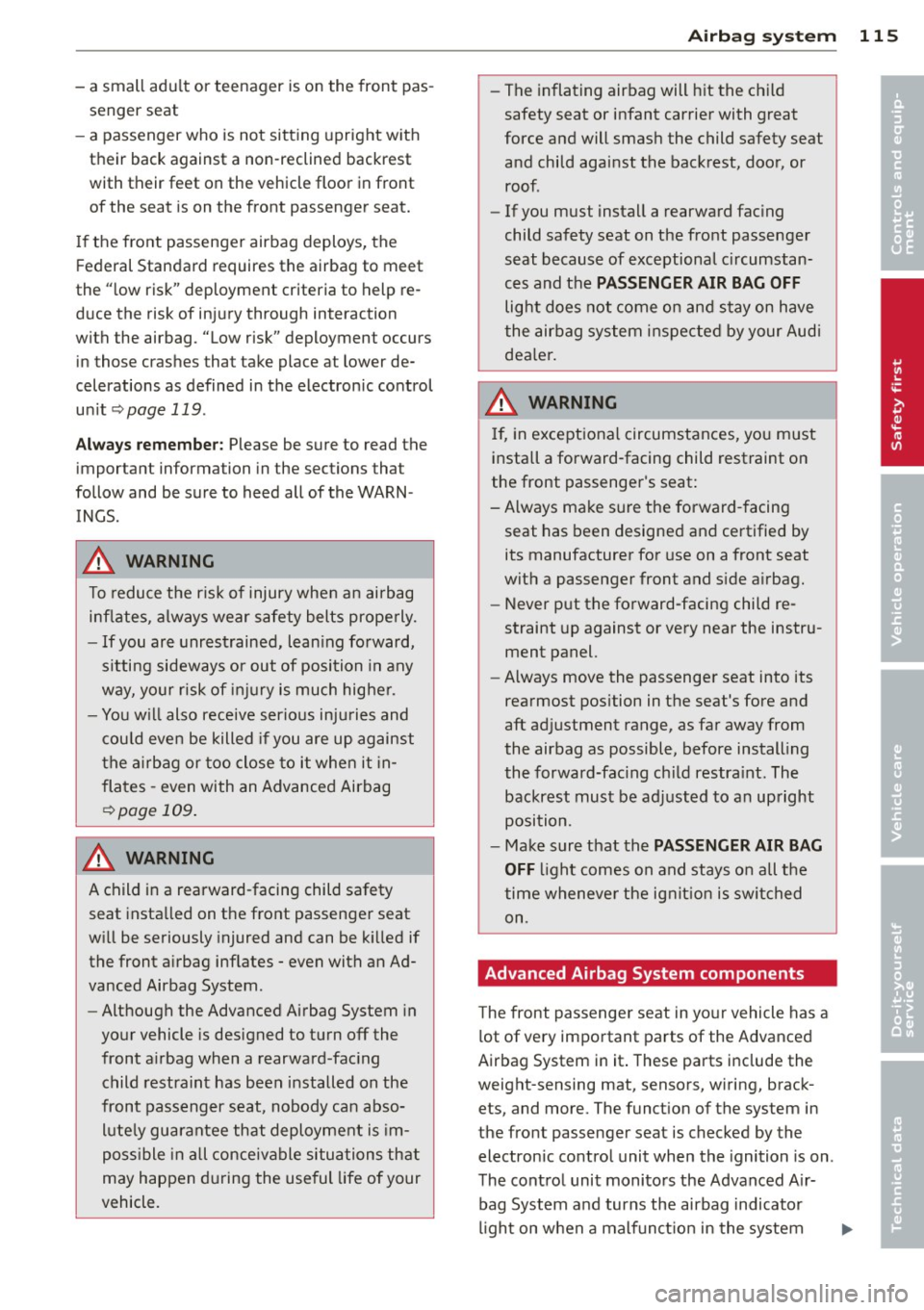
-a small adu lt or teenager is on the front pas
senger seat
- a passenger who is not sitting upright w ith
their back against a non-reclined backrest
with their feet on the vehicle floor in front
of the seat is on the front passenger seat.
I f the front passenger airbag deploys, the
Federal Standard requires the airbag to meet
the " low risk" deployment criteria to help re
duce the risk of injury through interaction
with the airbag . "Low risk" deployment occurs
in those crashes that take place at lower de
celerations as defined in the electron ic control
un it
¢ page 119 .
Alw ays rem emb er: Please be sure to read the
important information in the sections that
follow and be sure to heed all of the WARN
INGS.
A WARNING
To reduce the risk of injury when an airbag inflates, a lways wear safety belts prope rly.
- If you are unrestrained, lean ing forward,
sitting sideways or out of position in any
way, your risk of inj ury is much higher.
- You w ill also receive serious inju ries and
cou ld even be killed if you are up against
the a irb ag or too close to it when it in
flates - even with an Advanced Airbag
¢page 109 .
.&_ WARNING
-
A child in a rearward-facing child safety
seat installed on the front passenger seat
w ill be seriously injured and can be k illed if
the front a irbag inflates - even with an Ad
vanced Airbag System.
- Although the Advanced Airbag System in
your vehicle is designed to turn off the
front a irbag when a rearward-fac ing
child restraint has been installed on the
front passenger seat, nobody can abso l u te ly guarantee that deployment is im
poss ible in a ll conceivable situations that
may happen d uring the useful life of your
vehicle.
A irbag system 11 5
-The inflating airbag will hit the child
safety seat or infant carrier with great
force and will smash the child safety seat and child against the backrest, doo r, or
roof.
- If you must install a rearward fac ing
child safety seat on the front passenger
seat because of exceptional c ircumstan
ces and the
PASSENGER AIR BAG OFF
light does not come on and stay on have
the airbag sys tem inspected by your Audi
dea ler.
.&_ WARNING
I f, in except iona l circumstances, you must
install a forward-facing child restraint on
the front passenger's seat:
- Always make sure the forward -facing
seat has been designed and certified by its manufacturer for use on a front seat
with a passenger front and s ide a irbag.
- Never put the forward-facing child re
straint up against or very near the instru
ment panel.
- Always move the passenger seat into its
rearmost pos ition in the seat's fore and
aft adjustment range, as far away from
the airbag as possible, before installing
the forward-fac ing ch ild restra int. The
backrest must be ad justed to an upright
position.
- Make sure that the
PASSENGER AIR BAG
OFF
li ght comes on and stays o n all the
time wheneve r the ig nit ion is swit ched
on.
Advanced Airbag System components
T he front passenge r seat in yo ur vehicle has a
lot of very important parts of the Advanced
Airbag System in it . These parts include the
weight-sensing mat, sensors, wiring, brack ets, and more. The funct ion of the system in
the front passenger seat is checked by the
electronic control unit when the ignition is on .
The cont rol unit monitors the Advanced A ir
bag System and turns the airbag indicator
l igh t on when a malfunct ion in the system
•
•
Page 118 of 244
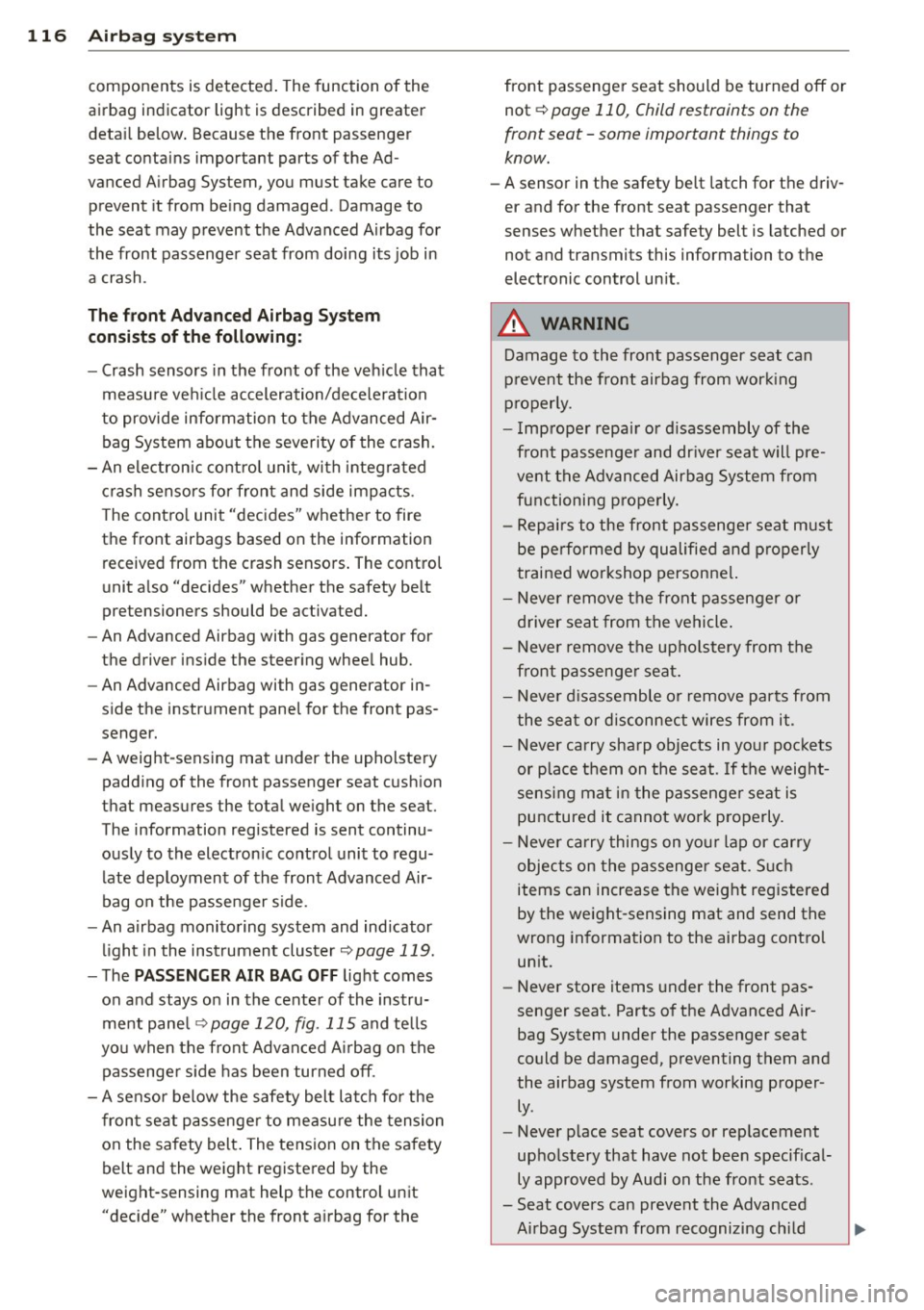
116 Airbag sys te m
components is detected . The function of the
airbag indicator light is described in greater
deta il below . Because the front passenger
seat contains important parts of the Ad
vanced A irbag System, you must take care to
prevent it from be ing damaged . Damage to
the seat may prevent the Advanced Airbag for
the front passenge r seat from doing its job in
a crash .
The front Ad vanced Airb ag System
consists of the following:
- Crash sensors in the front of the veh icle that
measure ve hicle acceleration/decele ra tion
to provide info rmation to the Advanced Air
bag System abo ut the severi ty of the crash.
- An electron ic co ntro l unit, with integra ted
crash sensors for front and side impacts .
T he cont ro l unit "decides " whethe r to fire
the front airbags based on the information received from the crash sensors . The contro l
unit a lso "decides" whether the safety belt
pre tensioners should be activated.
- An Advanced Ai rbag with gas generator for
the driver ins ide the steer ing whee l hub.
- An Advanced Airbag with gas generator in
s ide the inst rument panel for the front pas
senger.
- A weight -sens ing mat under the upholstery
padd ing of the front passenger seat cush ion
that measures the total we ight on the seat.
The information reg istered is sent continu
ous ly to the electron ic control unit to regu
late deployment of the front Advanced Air
bag on the passenger s ide.
- An airbag monito ring system and indicator
li ght in the instrument cluster
9 page 119.
- T he PASSENGER AIR BAG OFF light comes
on and stays on in the cente r of the instru
ment pane l
9 page 120, fig. 115 and tells
yo u when the front Advanced A irbag on the
passenge r side has been turned off.
- A senso r be low the safety bel t latch fo r the
fron t se at passenge r to me asu re the tension
on the safety belt . The tension on the safety
belt and the weight registe red by the
weight -sensing mat help the control unit
"decide" whether the front a irbag for the front passenge
r seat should be turned off or
not
¢ page 110, Child restraints on the
front seat -some important things to
know.
- A sensor in the safety be lt latch fo r the driv
er and for the front seat passenger that
senses whether that safety belt is latched or not and transmits this informa tion to the
electronic control un it .
.&_ WARNING
D amage to the fron t passenger seat can
p revent the fro nt airbag from wor king
pr operly.
- I mp roper repai r or disassembly of the
front passenge r and dr ive r sea t will pre
vent the Advanced Airbag System from
functioni ng p roperly.
- Repairs to the front passenge r seat mus t
be pe rformed by qu alifie d and p roperly
trained workshop personne l.
- Never remove the front p assenger o r
d river seat from the vehicle .
-Never remove th e upholstery from the
front passenger seat.
- Neve r d isassemble o r remove parts from
the sea t or discon nect wires from it.
- Never carry sha rp objects in yo ur poc kets
or p lace t hem on the seat. If the weight
sensing ma t in the passenger seat is
punctured it cannot work p roperly.
- Neve r carry things on y our la p or ca rry
objects on the passenger seat. S uc h
items can increase the weight registere d
by the weight -sensing mat and send the
wrong information to the airbag control
un it.
- Never store items under the front pas
senger seat. Parts o f the Advanced Air
bag System under the passenger seat
could be damaged, preventing them and
the airbag system from working proper ly.
- Never p lace seat covers or rep lacement
up ho lstery that have not been specifica l
ly approved by Audi on the front seats .
- Seat covers can prevent the Advanced
-
Ai rbag System from recognizing chi ld .,..
Page 119 of 244
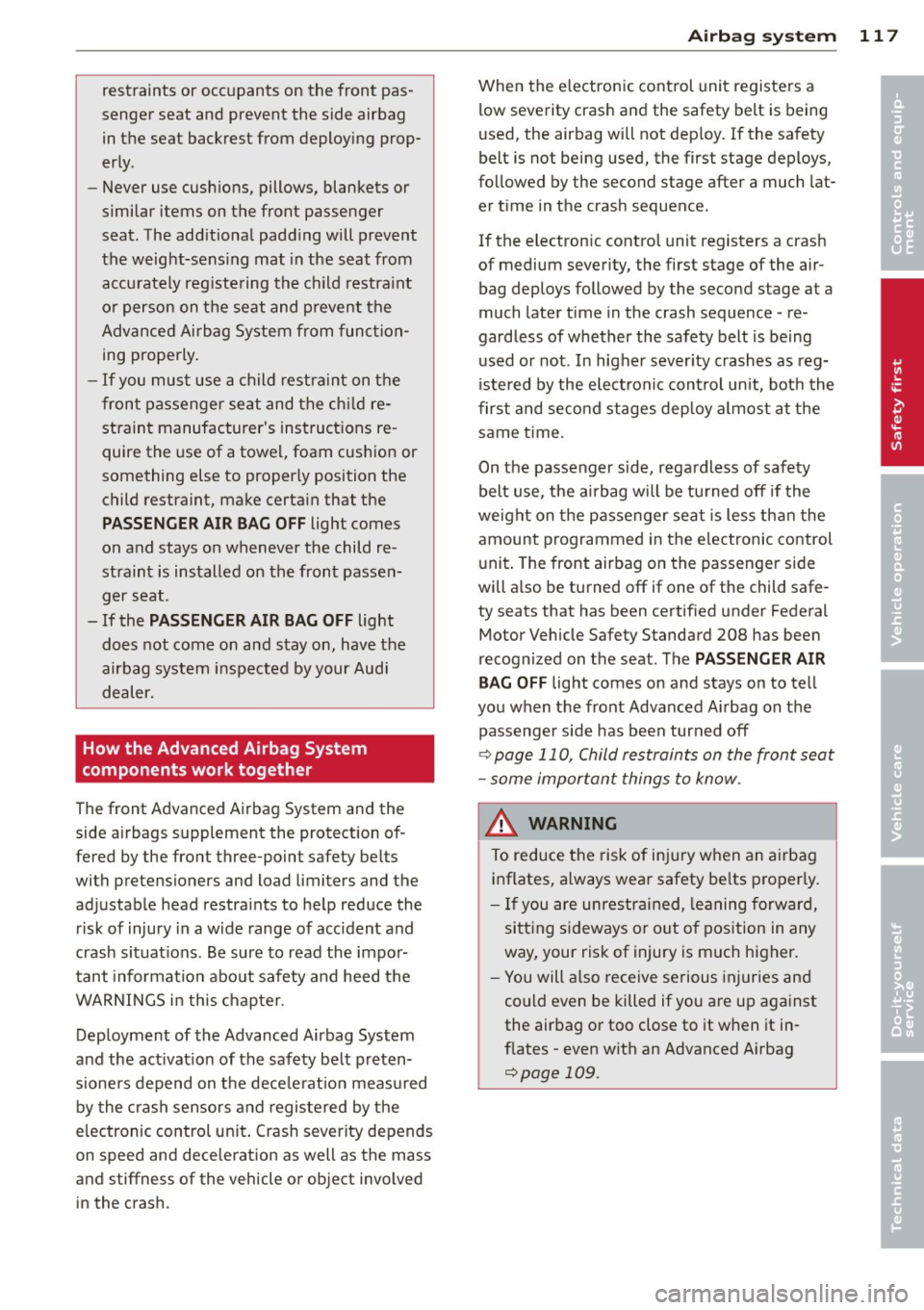
restraints or occupants on the front pas
senger seat and prevent the side airbag
in the seat backrest from deploying prop
erly.
- Never use cushions, pillows, blankets or
similar items on the front passenger
seat. The add itional padd ing will prevent
the weight-sens ing mat in the seat from
accurately reg istering the ch ild restra int
or person on the seat and preve nt the
Advanced Airbag System from func tion
ing properly .
- If you must use a child restra int on the
front passenger seat and the ch ild re
straint manufacturer's instructions re
quire the use of a towel, foam cush ion or
something else to properly position the
child restraint, make certa in that the
PASSENGER AIR BAG OFF light comes
on and stays on whenever the child re
st ra int is installed on the front passen
ger seat .
- If the
PAS SENGER AIR BAG OFF light
does not come on and stay on, have the
airbag system inspected by your Audi dealer.
How the Advanced Airbag System
components work together
The front Advanced Airbag System and the side airbags s upplement the protection of
fered by the front three-point safety be lts
with pretensioners and load limiters and the
adjustab le head restra ints to he lp reduce the
risk of injury in a wide range of acc ident and
crash situat ions . Be sure to read the impor
tant information about safety and heed the
WARNINGS i n this chapter .
Deployment of the Advanced Airbag System
and the act ivat ion of the safety be lt preten
sioners depend on the dece le rat ion measured
by the c rash sensors and registered by the
e lectronic control un it . Crash severity depends
on speed and dece leration as well as the mass
and stiffness of the vehicle or object involved in the crash .
Airbag system 117
When the electronic control unit registers a
low severity cras h and the safety belt is being
used, the airbag will not dep loy. If the safety
belt is not being used, the first stage deploys,
followed by the second stage after a much lat er t ime in the crash sequence.
If the electron ic control unit registers a crash
of medium severity, the first stage of the air bag deploys followed by the second stage at a
much later time in the crash sequence -re
gardless of whether the safety belt is be ing
used or not . In higher sever ity crashes as reg
iste red by the elect roni c cont rol unit, bot h the
first and se cond s tages deploy almost at the
same t ime.
On the passenger side, regardless of safety
belt use, the airbag w ill be tu rned off if the
weight on the passenger sea t is less than the
amount programmed in the electronic control
u nit . The front airbag on the passenger side
will a lso be turned off if one of the child safe
ty seats that has been certified under Federal
Motor Vehicle Safety Standard 208 has been
recognized on the seat. The
PASS ENGER A IR
BAG OFF light comes on and stays on to te ll
you when the front Adva nced A irbag on the
passenger side has been turned off
¢ page 110, Child restraints on the front seat
- some important things to know .
_&. WARNING ~
To reduce the risk of inj ury when an a irbag
inflates, always wear safety be lts properly.
- If you are unrestrained, leaning forward,
sitting sideways or o ut o f position in any
way, your risk of injury is m uch higher.
- You will a lso receive serious injur ies and
could even be killed if yo u are up against
the airbag or too close to it when it in
f lates -even with an Advanced A irbag
¢page 109.
•
•
Page 120 of 244
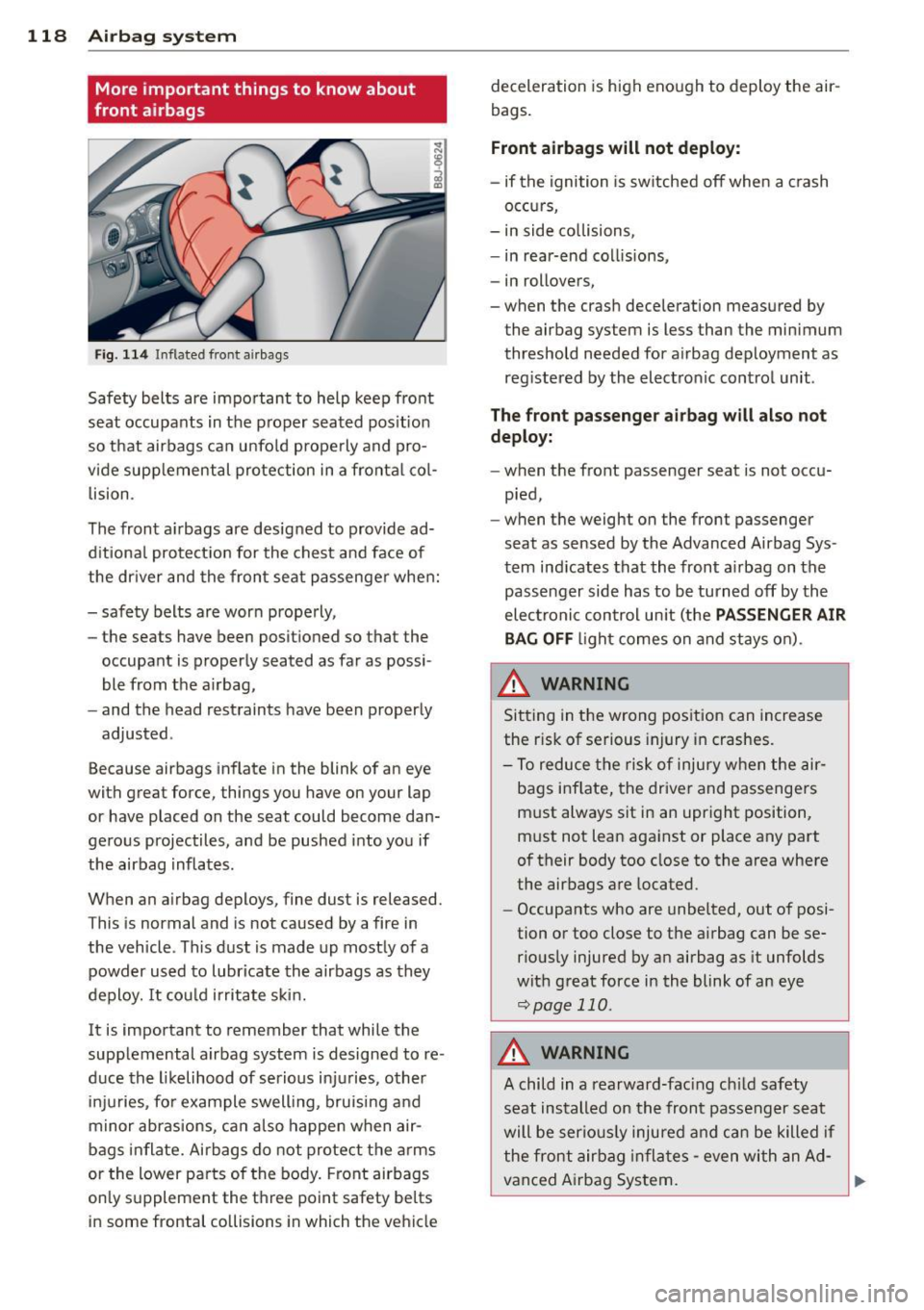
118 Airbag system
More important things to know about
front airbags
F ig. 114 Inflated fro nt airbags
Safety belts are impo rtant to help keep fro nt
seat occupants in the p roper seated pos it io n
so that airbags can unfo ld prope rly and pro
vide supplemental protection in a fronta l co l
lision .
The front a irbags are designed to provide ad
d itiona l protect ion for the chest and face of
the dr iver and the front seat passenger when:
- safety belts are worn properly,
- the seats have been positioned so that the
occupant is properly seated as far as possi
ble from the a irbag,
- and the head restraints have been properly
adjusted .
Because airbags inflate in the blink of an eye
with great force, things you have on your lap or have placed on the seat could become dan
gerous projectiles, and be pushed into you if
the airbag inflates .
When an a irbag deploys, fine dust is released.
This is normal and is not caused by a fire in
the vehicle . This dust is made up mostly of a
powder used to lubricate the airbags as they
deploy. It cou ld irritate ski n.
It is important to remember that while the
supp lemental airbag system is designed to re
duce the l ikelihood of serious inj uries, other
i n juries, fo r example swelling, bruisi ng and
m inor abrasions, ca n also happe n when air
bags in flate. Airbags do not protect the a rms
or the lower pa rts of the body. Front airbags
only supplement the t hree point safety belts
in some frontal collisions in which the vehicle deceleration
is high eno ugh to deploy the air
bags .
Front airbags will not deploy:
- if the ignition is sw itched off when a crash
occurs,
- in side co llisions,
- in rear-end co llisions,
- in rollovers,
-when the crash deceleration measured by the airbag system is less than the min imum
threshold needed for a irbag deployment as
reg istered by the electronic control unit .
The front pass enge r airbag will al so not
deploy:
- when the front passenger seat is not occu
p ied,
- when the weight on the front passenger
seat as sensed by the Advanced Airbag Sys
tem indicates that the front ai rbag on the
passenger side has to be turned off by the
elec troni c control un it (the
PASSENGER AIR
BAG OFF
li ght comes on and stays o n).
_&. WARNING ~
Si tting in the wrong position can increase
the r isk of se rious injury in crashes.
- To reduce the risk of inju ry w he n t he air
bags inflate, the drive r and passengers
must always sit in an upr ight position,
m ust not lean aga inst or place any part
of their b ody too close to the area where
the airbags a re located .
- Occupants who are unbelted, out of posi
tion or too close to the a irbag can be se
rio usly injured by a n airbag as it unfolds
wit h great force in the blink of an eye
¢page 110 .
_&. WARNING ~ -
A child in a rearward-fac ing c hild safety
seat installed on the front passenger seat
will be serio usly injured and ca n be killed if
the front airbag in fla tes -even with an Ad
vanced A irbag System.